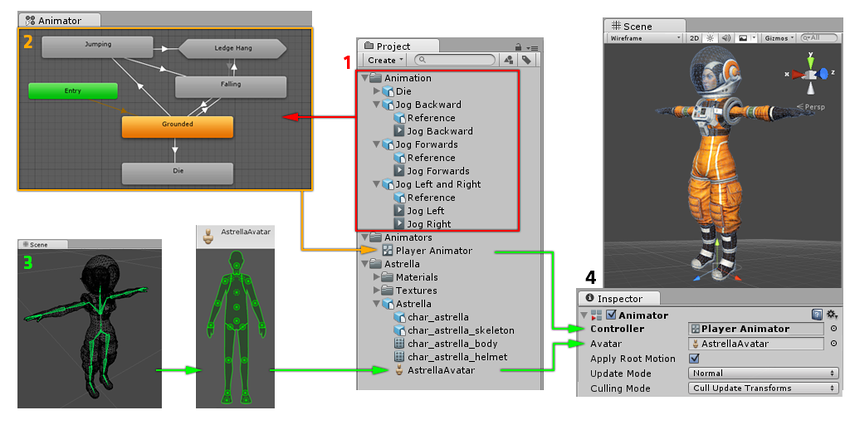Animation Introduction
Unity has a rich and sophisticated animation system (referred as 'Mecanim'), which provides:
Easy workflow and setup of animations for all elements of Unity
Support for imported animation clips and animations created within Unity
Humanoid animation retargeting, the ability to apply animations from one character model onto another
Simplified workflow for aligning animation clips
Convenient preview of animations clips, transitions and interactions between them.
Management of complex interactions between animations with a visual programming tool
Animation different body parts with different logic
Layering and masking features
Mecanim is based on the concept of Animation Clips, which contain information about how certain objects should change their position, rotation, or other properties over time. The Animation Clips come from external sources like Max, Maya, motion capture studios or other sources.
Animation Clips are then organised into a structured flowchart-like system called Animator Controller. It acts as a State Machine, which keeps track of which clip should currently be playing and when the animations should change or blend together.
Mecanim also has numerous special features for handling humanoid characters, like the ability to retarget humanoid animation from any source to your own character model, as well as adjusting muscle definitions.
These special features are enabled by Unity Avatar system, where humanoid characters are mapped to a common internal formal.
Each one of these pieces (Animation Clips, Animator Controller and Avatar) are brought together on a GameObject via the Animator Component.
This component has a reference to an Animator Controller and, if required, the Avatar. The Animator Controller contains the references to the Animation Clips it uses.

The Animation Clips that are imported from an external source
The Animation Clips are placed and arranged in an Animator Controller
The rigged character model has a specific configuration of bones which are mapped to an Avatar format
When managing the character model, it has an Animator component attached, where you can see its properties
The parameters are
Controller, Animator Controller attached
Avatar, Avatar attached
Apply Root Motion, if enable moves the transform to match the root of the animation
Update Mode, controls when and how often the Animator is updated
Normal, is updated in sync with the Update call
Animate Physics, is update in sync with the FixedUpdate call
Unscaled Time, is updated in sync with the Update call, but the animator speed ignores the current timescale and animates at 100% speed
Culling Mode, controls what is updated when the object has been culled
Always Animate, don't do culling even when offscreen
Cull Update Transforms, retarget, IK and write of Transforms are disabled when renderers are not visible
Cull Completely, animation is completely disabled when renderers are not visible